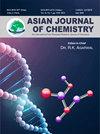Sustainable Industrial Wastewater Treatment and Antibacterial Activity using Environmental Friendly Ferrite Nanoparticles
Q4 Chemistry
引用次数: 0
Abstract
A comparison studies of two unique bimetallic spinel ferrite nanoparticles synthesized by the sol-gel process, namely Co-NiFe2O4 andCu-ZnFe2O4 were investigated. Various characterization approaches were utilized to examine the structural, morphological, magnetic and electrical characteristics of the nanoparticles. Both Co-NiFe2O4 and Cu-ZnFe2O4 nanoparticles formed single-phase spinel structures, according to X-ray diffraction (XRD) research whereas FTIR spectra provided information about the vibrational modes and chemical bonding within the nanoparticles confirmed the presence of desired metal-oxygen bonds chemical bonding within the nanoparticles. The UV-Vis spectroscopy revealed the optical absorption properties of the nanoparticles indicating the presence of energy bandgaps in the visible range. Scanning electron microscopy (SEM) images suggested the uniform and well-dispersed nanoparticles with average sizes in the nanoscale range. Vibrating sample magnetometry (VSM) measurements demonstrated that both Co-NiFe2O4 and Cu-ZnFe2O4 nanoparticles exhibited ferromagnetic behaviour at room temperature. The saturation magnetization values were found to be higher for Co-NiFe2O4 nanoparticles compared to Cu-ZnFe2O4 nanoparticles, suggesting the superior magnetic properties of the former. As a result, ferrites demonstrate promise in industrial wastewater treatment, facilitating efficient heavy metal removal and advanced organic pollutant degradation, contributing to a sustainable and effective solution. The antibacterial efficacy of synthesized bimetallic ferrite nanoparticles against Salmonell typhi, Escherichia coli, Staphyloccus aureus, Bacillus cereus proves that the synthesized ferrite nanoparticles possess a good antibacterial activity against the selected pathogens.利用环境友好型铁氧体纳米粒子实现可持续工业废水处理和抗菌活性
本研究比较研究了通过溶胶-凝胶工艺合成的两种独特的双金属尖晶石铁氧体纳米粒子,即 Co-NiFe2O4 和 Cu-ZnFe2O4。利用各种表征方法对纳米粒子的结构、形态、磁性和电性特征进行了研究。根据 X 射线衍射(XRD)研究,Co-NiFe2O4 和 Cu-ZnFe2O4 纳米粒子都形成了单相尖晶石结构,而傅立叶变换红外光谱则提供了有关纳米粒子内振动模式和化学键的信息,证实了纳米粒子内存在所需的金属氧键化学键。紫外可见光谱显示了纳米颗粒的光学吸收特性,表明在可见光范围内存在能带隙。扫描电子显微镜(SEM)图像显示,纳米颗粒均匀且分散良好,平均尺寸在纳米级范围内。振动样品磁力计(VSM)测量表明,Co-NiFe2O4 和 Cu-ZnFe2O4 纳米粒子在室温下均表现出铁磁性。与 Cu-ZnFe2O4 纳米粒子相比,Co-NiFe2O4 纳米粒子的饱和磁化值更高,这表明前者具有更优越的磁性能。因此,铁氧体有望用于工业废水处理,促进重金属的高效去除和有机污染物的高级降解,为可持续的有效解决方案做出贡献。合成的双金属铁氧体纳米粒子对伤寒沙门氏菌、大肠杆菌、金黄色葡萄球菌和蜡样芽孢杆菌的抗菌效果证明,合成的铁氧体纳米粒子对所选病原体具有良好的抗菌活性。
本文章由计算机程序翻译,如有差异,请以英文原文为准。
求助全文
约1分钟内获得全文
求助全文
来源期刊

Asian Journal of Chemistry
化学-化学综合
CiteScore
0.80
自引率
0.00%
发文量
229
审稿时长
4 months
期刊介绍:
Information not localized
 求助内容:
求助内容: 应助结果提醒方式:
应助结果提醒方式:


